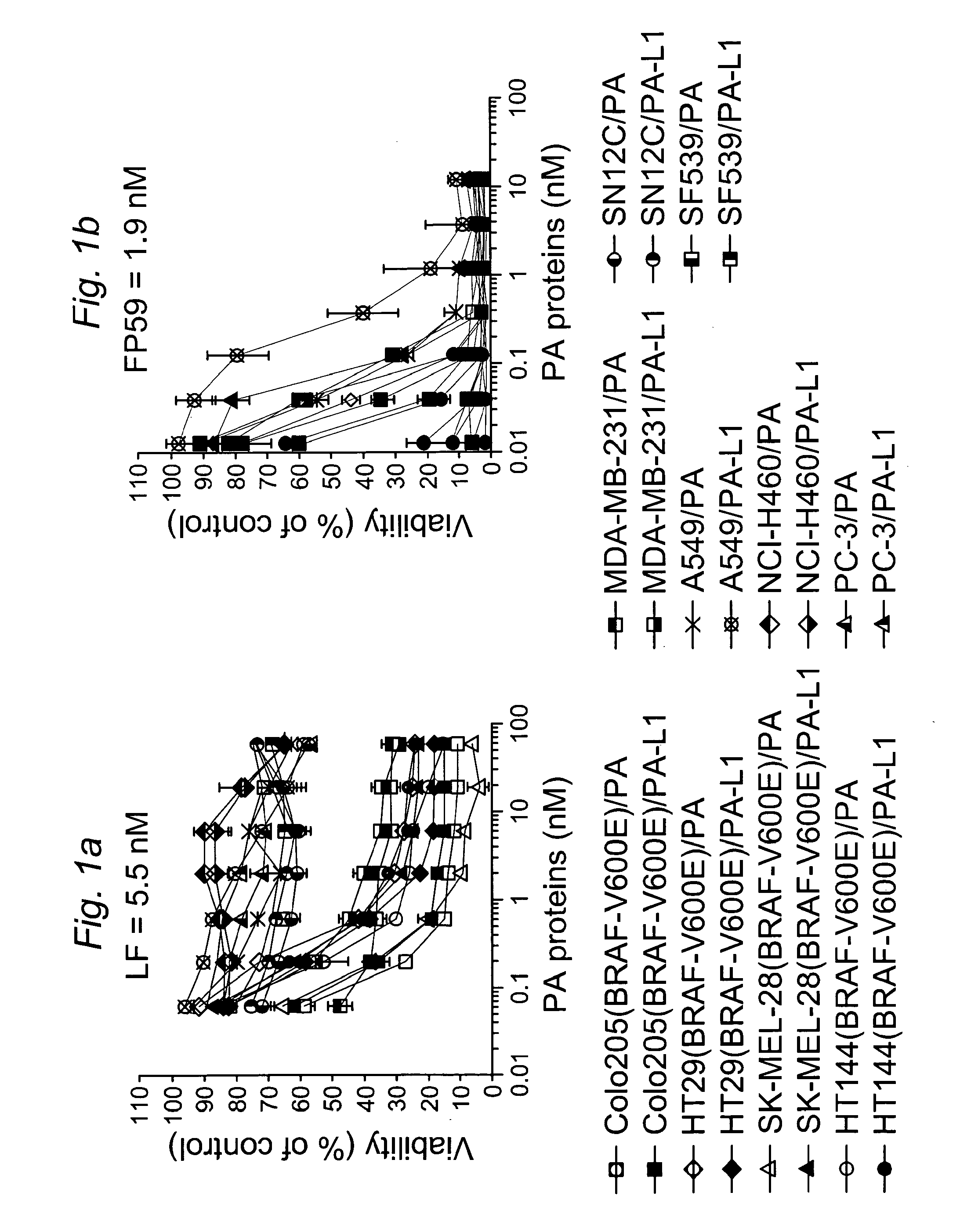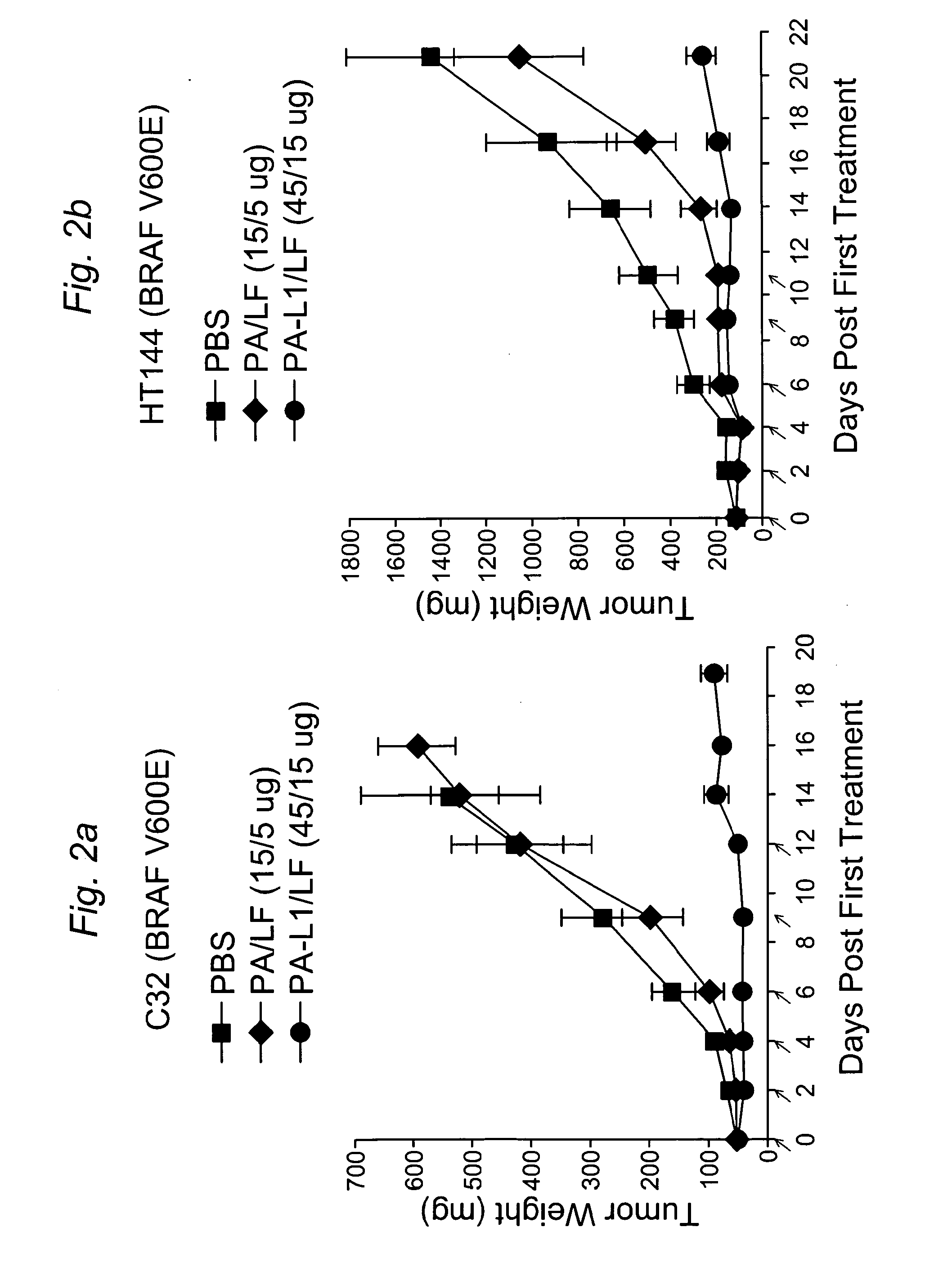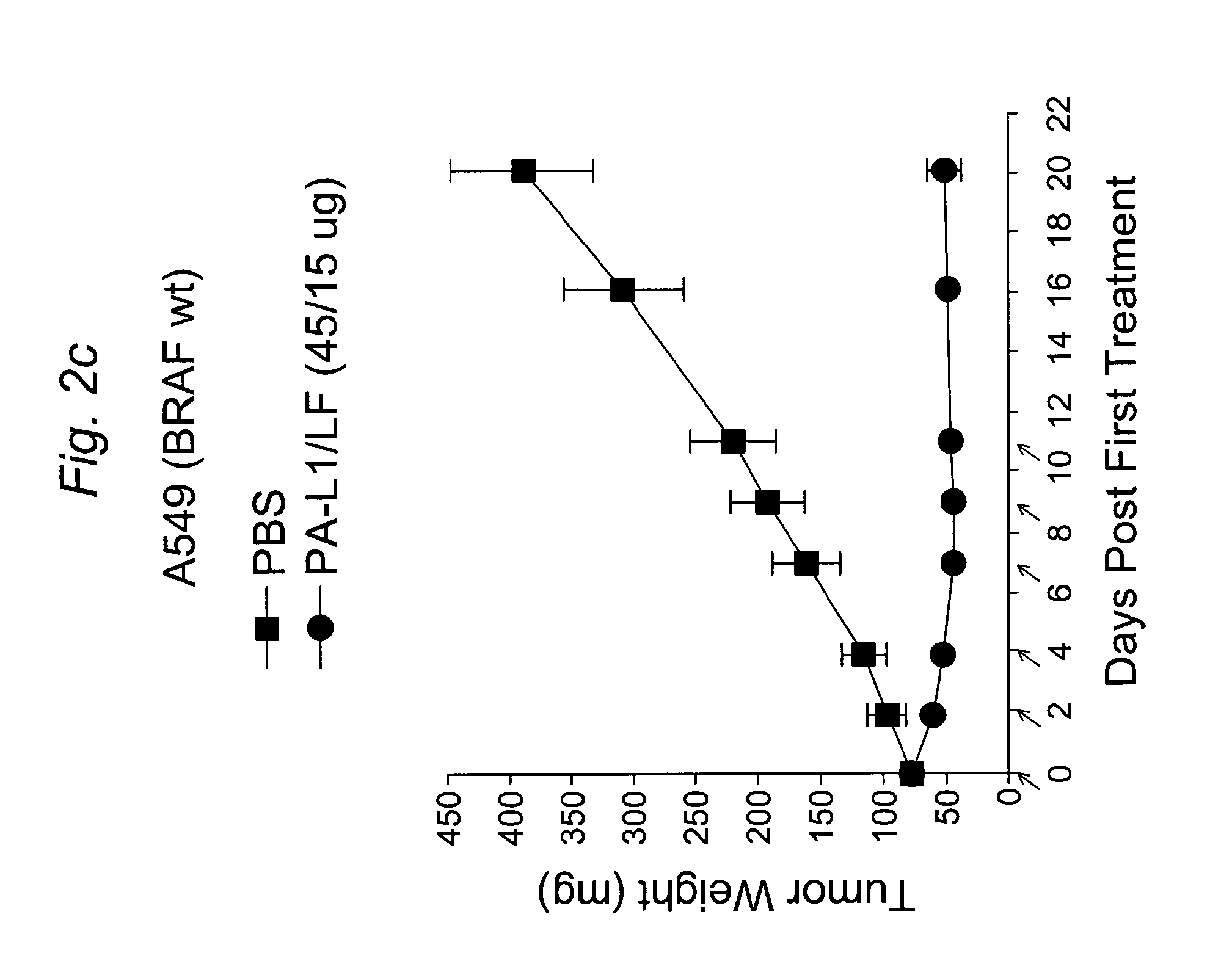Human cancer therapy using engineered matrix metalloproteinase-activated anthrax lethal toxin that targets tumor vasculatuture
a technology of anthrax and tumor vasculature, which is applied in the direction of antineoplastic agents, drug compositions, peptide/protein ingredients, etc., can solve the problems of high tumor toxicity of engineered toxins, not only showing much lower toxicity, etc., and achieves potent anti-tumor activity, reduce toxicity, and reduce in vivo toxicity
- Summary
- Abstract
- Description
- Claims
- Application Information
AI Technical Summary
Benefits of technology
Problems solved by technology
Method used
Image
Examples
example 1
MMP-Activated Anthrax Lethal Toxin is Cytotoxic to Human Cancer Cells with the BRAF V600E Mutation
[0134]PA-L1 is a mutated PA protein with the furin cleavage site, RKKR, replaced by a MMP-susceptible cleavage sequence, GPLGMLSQ (Liu, S. et al., Cancer Res., 60:6061-6067 (2000)). To evaluate the in vitro anti-tumor activity of the MMP-activated LT (PA-L1 / LF), cytotoxicity analyses were performed on four BRAF V600E-containing tumor cell lines from the NCI60 cell set (Shoemaker, R. H., Nat. Rev. Cancer, 6:813-823 (2006)), Colo205 (colon), HT29 (colon), SK-MEL-28 (melanoma), and HT144 (melanoma), in comparison to six BRAF wild type lines, MDA-MB-231 (breast), A594 / ATCC (lung), NCI-H460 (lung), PC-3 (prostate), SN12C (renal), and SF539 (central nervous system). We found that PA-L1 / LF was cytotoxic to both melanoma and colon cancer cells having the BRAF mutation at potencies comparable to those of wild-type LT (PA / LF) for these cells (FIG. 1A). However, all the tumor cells (except MDA-MB-...
example 2
Attenuated In Vivo Toxicity of the MMP-Activated Anthrax Lethal Toxin
[0136]We next evaluated the toxicity of PA-L1 / LF in vivo. Mice were challenged intraperitoneally (i.p.) with 6 doses (three times a week with two-day intervals for two weeks) of PA / LF or PA-L1 / LF. A molar ratio of 3:1 of PA protein to LF was used in the challenge experiments based on the fact that each PA heptamer can bind and deliver up to three molecules of LF into cells (Mogridge, J. et al., Proc. Natl. Acad. Sci. U.S.A., 99:7045-7048 (2002)). C57BL / 6 mice could tolerate 6 doses of 10 / 3.3 μg of PA / LF, but could not tolerate doses beyond 15 / 5 μg of PA / LF. One of 10 mice died after 6 doses of 15 / 5 μg of PA / LF; and 11 of 11 died after 2 doses of 30 / 10 μg of PA / LF (Table 1). Several major organ damages associated with vascular collapse had been identified as major lesions in LT-treated mice (Moayeri et al., J. Clin. Investing., 112, 670-682 (2003). In contrast, the mice tolerated as many as 6 doses of 45 / 15 μg of PA...
example 3
MMP-Activated Anthrax Lethal Toxin has Potent and Broad Anti-Tumor Activity In Vivo
[0137]To determine whether the anti-tumor activity of PA-L1 / LF in vitro can be recapitulated in vivo, we established human tumor xenografts in nude mice using human melanoma HT144 cells and C32 cells, containing the BRAF V600E mutation, and human non-small cell lung carcinoma A549 / ATCC cells, which lack the BRAF mutation. After these tumors were well established, the mice were injected (i.p.) with 6 doses of 45 / 15 μg of PA-L1 / LF (MTD6), 6 doses of 15 / 5 μg of PA / LF (≈MTD6), or PBS. Remarkably, the two human melanomas with the BRAF mutation were very sensitive to PA-L1 / LF, with average tumor sizes just 16% and 17%, respectively, of the control tumors treated with PBS at the time when the control mice required euthanasia due to tumor ulceration in compliance with institutional guidelines (FIG. 2A and FIG. 2B). In the case of C32 melanomas, 30% of the tumors achieved complete regression. In contrast, we o...
PUM
| Property | Measurement | Unit |
|---|---|---|
| wound healing time | aaaaa | aaaaa |
| pH | aaaaa | aaaaa |
| pH | aaaaa | aaaaa |
Abstract
Description
Claims
Application Information
 Login to View More
Login to View More - R&D
- Intellectual Property
- Life Sciences
- Materials
- Tech Scout
- Unparalleled Data Quality
- Higher Quality Content
- 60% Fewer Hallucinations
Browse by: Latest US Patents, China's latest patents, Technical Efficacy Thesaurus, Application Domain, Technology Topic, Popular Technical Reports.
© 2025 PatSnap. All rights reserved.Legal|Privacy policy|Modern Slavery Act Transparency Statement|Sitemap|About US| Contact US: help@patsnap.com



